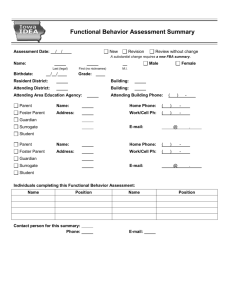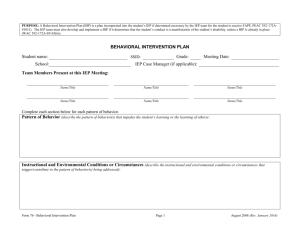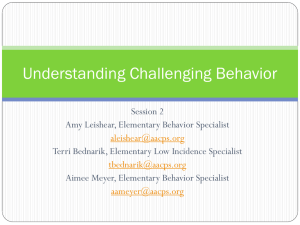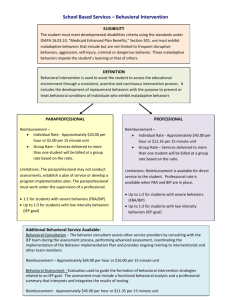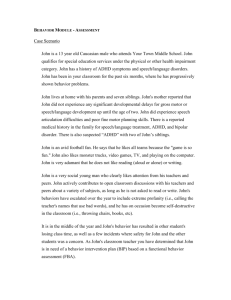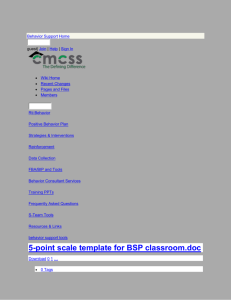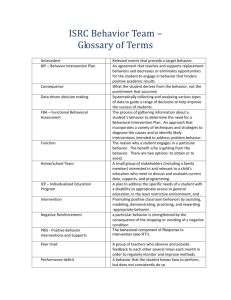PPT with Notes
advertisement
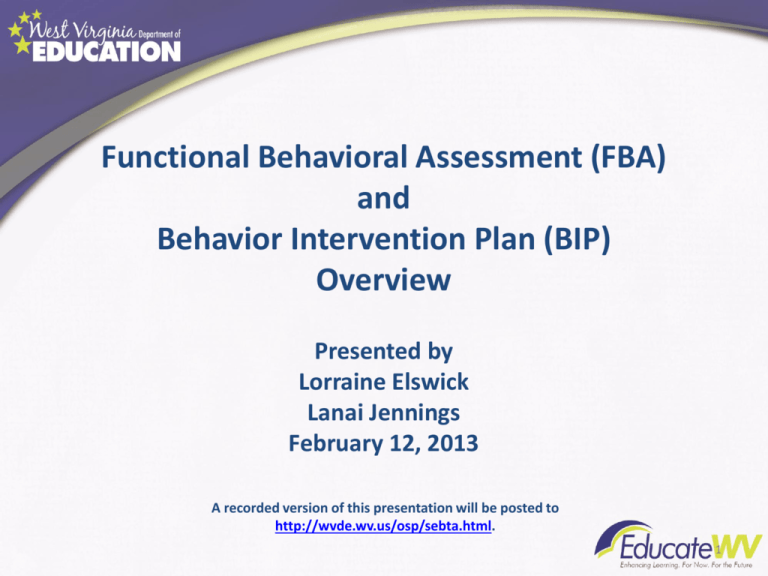
Functional Behavioral Assessment (FBA) and Behavior Intervention Plan (BIP) Overview Presented by Lorraine Elswick Lanai Jennings February 12, 2013 A recorded version of this presentation will be posted to http://wvde.wv.us/osp/sebta.html. 1 “Our challenge as educators is to make sure that we provide all children in our public schools the opportunity for success. Teachers of children with special needs understand this challenge more than most. They are dedicated individuals who have a passion for teaching and high expectations that every child can learn given an opportunity.” – James B. Phares, Ed.D. Support for Personalized Learning (SPL) Expected behaviors in safe and supportive schools create an education system that supports students in their efforts to become healthy, responsible and self-directed citizens. http://wvde.state.wv.us/spl/ Support for Personalized Learning Most children respond to typical classroom behavior management strategies or school wide positive behavioral interventions and supports. Definition of FBA from WV Policy 2419: Regulations for the Education of Students with Exceptionalities A FBA is a sequential, multi-step, team evaluation process that helps to determine the purpose and the effect of the problem behavior(s) so that IEP goals and objectives can be identified, and interventions and modifications can be developed and implemented, specifically through a student's Behavior Intervention Plan. Policy 2419 - Definition of a Behavior Intervention Plan (BIP) • Written, purposeful and individualized plan based upon a student's functional behavioral assessment. • Describes the positive behavioral interventions, strategies and supports required to implement the student's IEP goals and objectives in the areas of social, emotional and/or behavioral development. Policy 2419 Components of BIP The BIP may include, but is not limited to: • Environmental modifications that reduce the likelihood of the problem behavior; • Guidance, structured opportunities and/or instruction in the use of new skills as a replacement for problem behaviors; • Consequences to promote positive change and diminish problem behavior; • A crisis management plan (if appropriate); and • Procedures for monitoring, evaluating and reassessing the plan as necessary. When is a FBA/BIP required? As a result of a student’s disciplinary removal when the student’s conduct is determined to be a manifestation of the student’s disability, the IEP Team must: 1. Conduct a FBA and develop a BIP if one has not been completed; or 2. Review the existing BIP and revise as needed to address the student’s current behavior(s); and 3. Return the student to the placement from which the student was removed unless the parent and the district agree to a change of placement as part of the modification of the BIP as determined by the IEP Team. Policy 2419, p 69 When is a FBA/BIP necessary? Student data indicates: • High intensity or frequency of behavior • Behavior impedes his or her academic performance or the performance of others • Team needs additional information to understand why the behavior continues • Typical supports or interventions have not been successful Crone, D.A. & Horner, R.H., 2003 FBA is a Process Not an Event The IDEA does not define how a FBA is conducted. The process may vary with the needs of each child. However, several specific steps are always part of this assessment. What are the components of a FBA/BIP? 1. 2. 3. 4. Identify and define the target behavior(s) for change. Collect data from multiple sources. Develop a hypothesis. Identify other alternative behaviors to replace or reduce the inappropriate one(s). 5. Develop an intervention considering the functional variables. Defining the Behavior Topography - What does the behavior look and sound like? - Frequency - Duration - Intensity Function - Why is the behavior occurring? - What purpose does the behavior serve for the student? Topography versus Function Throws Book To Avoid/Escape Topography To Gain boring work peer attention difficult work adult attention Function Step 1: Identify and Define the Target Behavior for Change What does the target behavior look like? Poor Attitude Aggressive Does not begin assignments when prompted Hits other students Curses Bites other students STEP 2: Collect Data from Multiple Sources What sequence of events predicts the target behavior? Setting Events Antecedent Behavior Consequence Teacher Request Curses Office Referral STEP 2: Collect Data from Multiple Sources What sequence of events predicts the target behavior? Setting Events Antecedent Playing with Peers Behavior Bites Consequence Remove Student to Teacher’s Desk/Area STEP 2: Collect Data from Multiple Sources What sequence of events predicts the target behavior? It is important to determine if the student’s target behavior is a result of a skill deficit (i.e., “can’t do”) or performance deficit (i.e., “won’t do”) for intervention planning purposes. Step 3: Develop a Hypothesis Statement A hypothesis statement is a summary statement that predicts the general conditions under which the target behavior is most and least likely to occur (antecedents), as well as the probable consequences that serve to maintain it. (Quinn, Gable et al., 1998) The goal of which is to identify specific CONCRETE events or environments more typically associated with the occurrence and nonoccurrence of the inappropriate behavior for intervention. Components of a FBA/BIP 1. Identify and define the target behavior(s) for change. 2. Collect data from multiple sources. 3. Develop a hypothesis. 4. Identify other alternative behaviors to replace or reduce the inappropriate one(s). 5. Develop an intervention considering the functional variables. Step 4: Identify other alternative behaviors to replace or reduce inappropriate behaviors An Appropriate Replacement / Alternate Behavior • Serves the same function as the target behavior, easier to do and more efficient than the target behavior • Alternate Behaviors require less physical effort & provide quicker, more reliable access to desired outcome/response than target behavior • Socially acceptable Step 5: Develop an intervention considering the functional variables • Manipulate the antecedents and/or consequences of the behavior • Teach more acceptable replacement behaviors that serve the same function as the inappropriate behavior • Implement changes in curriculum and instructional strategies • Modify the physical environment Step 5: Identify antecedents, consequences and alternative behaviors for manipulation to replace or reduce inappropriate behaviors Targeted Routine Antecedent Desired Behavior Target BehaviorCurses Alternate Behavior Natural Consequence Maintaining Consequence and Function Evaluate and Adjust the Intervention Plan • Are the baseline rates of the target behavior increasing or decreasing in the desired direction? • What intervention components can be tweaked, added or eliminated to result in greater efficacy? Teaching Behavior vs. Controlling Behavior Interventions Based on Control: Often fail to generalize Sometimes only suppress the behavior rather than provide an appropriate alternative behavior Interventions Based on Positive Behavior Supports: Teach student to address the source of the inappropriate behavior and skills needed for replacement & alternative behaviors Teaching Behavior • Don’t assume student knows how to exhibit appropriate behavior • Model & reinforce approximations to the desired behavior • Schedule review & practice of the behavior regularly. In Summary Positive Behavioral Intervention Options: • Replace problem behaviors with appropriate behaviors that serve the same (or similar) function as inappropriate ones • Increase rates of existing appropriate behaviors • Make changes to the environment that eliminate the possibility of engaging in inappropriate behavior • Provide the supports necessary for the child to use the appropriate behaviors. • Select a behavior that likely will be elicited by and reinforced in the natural environment. Providing Other Supports • • • • • Peers Teachers Paraprofessionals Related Service Providers Families Resources • • • • http://www.pbis.org http://www.nasponline.org/publications http://iris.peabody.vanderbilt.edu/ http://www.wrightslaw.com Thank you for your participation. At the conclusion of this webinar, please download the NCIPP mentor-mentee attachments. If you require additional assistance please contact Dr. Christina Chambers, Assistant Director, Office of Special Programs 304-558-2696 or via email at cdchambe@access.k12.wv.us.
